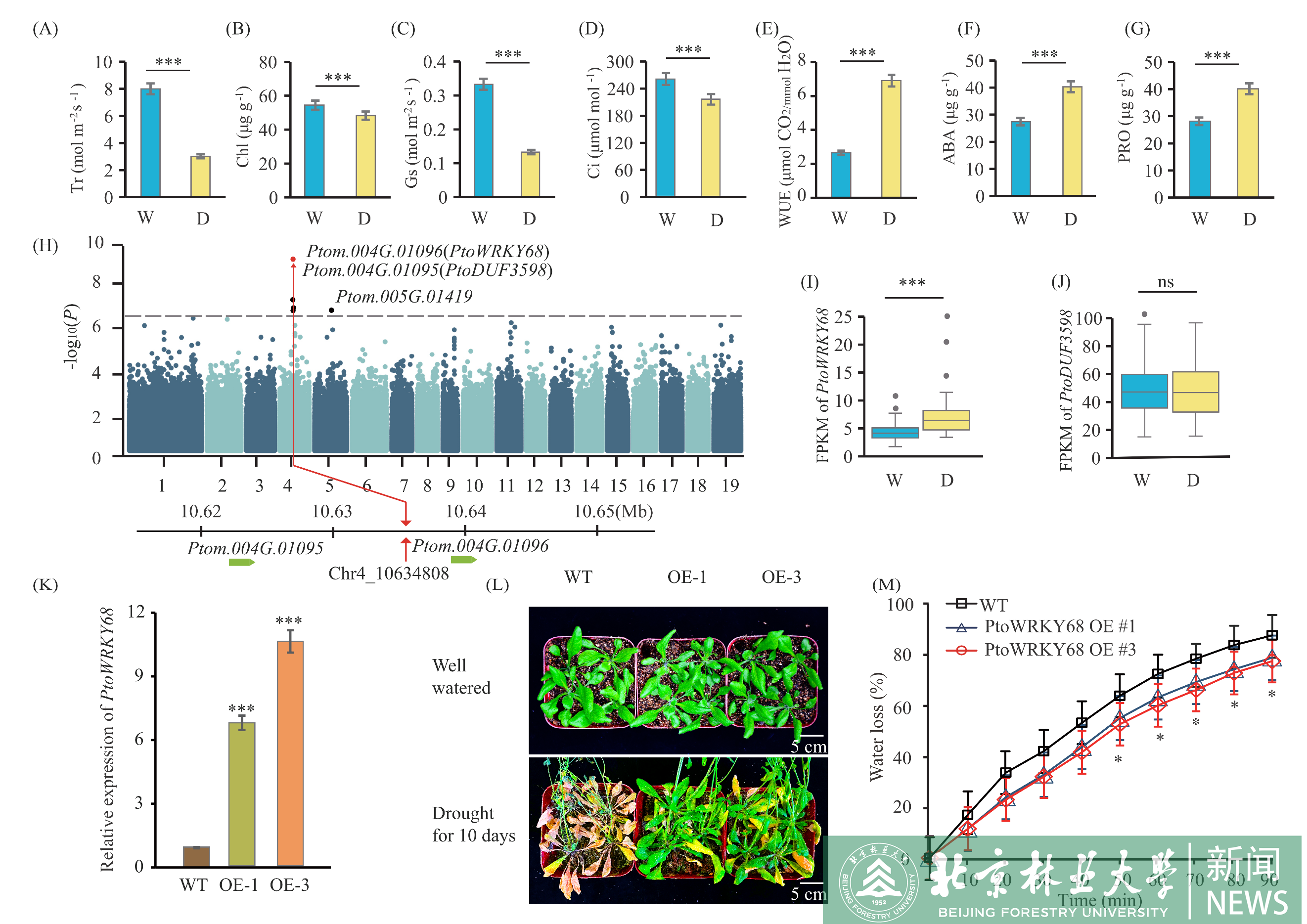Latest news
Recently, Zhang Deqiang's research group from the College of Biological Sciences and Technology, Beijing Forestry University, published a research paper entitled "Allelic variation in transcription factor PtoWRKY68 contributes to drought tolerance in Populus" in Plant Physiology (Q1, IF=9.115).
Drought stress is one of the most common abiotic stress factors affecting forest tree growth and productivity. Plant stem hydraulic conductance and aboveground biomass production decrease substantially under drought stress, resulting in up to 45% reduction in radial growth of many forest trees. To reduce the adverse effects of drought stress on plant growth and development, plants have evolved multifaceted strategies involving morphological, physiological, and biochemical adaptations . These strategies aim to alleviate or mitigate dehydration stress by increasing water uptake or reducing water loss, to protect plant cells from damage when water becomes scarce and tissue dehydration occurs. Forest trees, in general, are often challenged by mild or moderate drought stress, which requires trees to respond physiologically by reducing the rates of transpiration and photosynthesis to abrogate the acute desiccation that leads to death. Hence, investigation of the mechanisms underpinning the physiological and photosynthetic changes in trees under drought stress could enhance drought tolerance in trees and maintain their growth and productivity.

Drought stress limits woody species productivity and influences tree distribution. However, dissecting the molecular mechanisms that underpin drought responses in forest trees can be challenging due to trait complexity. Here, using a panel of 300 Chinese white poplar (Populus tomentosa) accessions collected from different geographical climatic regions in China, we performed a genome-wide association study (GWAS) on seven drought-related traits and identified PtoWRKY68 as a candidate gene involved in the response to drought stress. A 12-bp insertion and/or deletion and three nonsynonymous variants in the PtoWRKY68 coding sequence categorized natural populations of P. tomentosa into two haplotype groups, PtoWRKY68hap1 and PtoWRKY68hap2. The allelic variation in these two PtoWRKY68 haplotypes conferred differential transcriptional regulatory activities and binding to the promoters of downstream abscisic acid (ABA) efflux and signaling genes. Overexpression of PtoWRKY68hap1 and PtoWRKY68hap2 in Arabidopsis (Arabidopsis thaliana) ameliorated the drought tolerance of two transgenic lines and increased ABA content by 42.7% and 14.3% compared to wild-type plants, respectively. Notably, PtoWRKY68hap1 (associated with drought tolerance) is ubiquitous in accessions in water-deficient environments, whereas the drought-sensitive allele PtoWRKY68hap2 is widely distributed in well-watered regions, consistent with the trends in local precipitation, suggesting that these alleles correspond to geographical adaptation in Populus. Moreover, quantitative trait loci analysis and an electrophoretic mobility shift assay showed that SHORT VEGETATIVE PHASE (PtoSVP.3) positively regulates the expression of PtoWRKY68 under drought stress. The research team propose a drought tolerance regulatory module in which PtoWRKY68 modulates ABA signaling and accumulation, providing insight into the genetic basis of drought tolerance in trees. The findings will facilitate molecular breeding to improve the drought tolerance of forest trees.

The corresponding author of the paper is Professor Zhang Deqiang, and the co-authors are Ph.D students Fang yuanyuan, Wang Dan, and postdoctor Xiao Liang. Song Fangyuan, Zhou Jiaxuan, and other faculties and students from BFU and universities and institutes at home and abroad also participated in the study.
The study was supported by the Major Project of Agricultural Biological Breeding (No. 2022ZD0401502), the Project of National Natural Science Foundation of China (No. 32170370), the Project funded by China Postdoctoral Science Foundation (No. 2022M710406) and the 111 Project (No. B20050). The funding body had no involvement in designing the study or collecting, analyzing, or interpreting data, or in writing the manuscript.
Paper link: https://academic.oup.com/plphys/advance-article/doi/10.1093/plphys/kiad315/7185702












